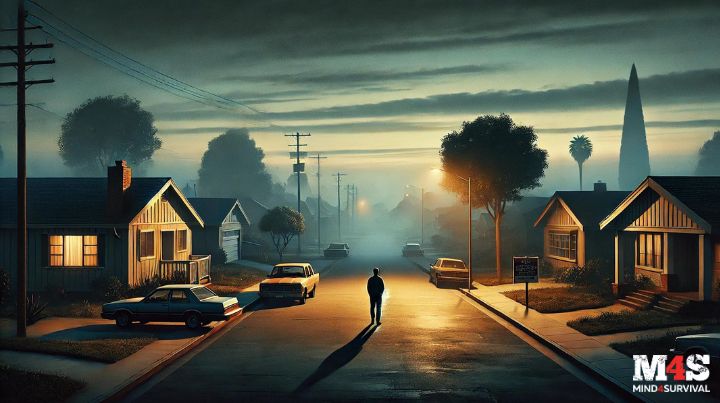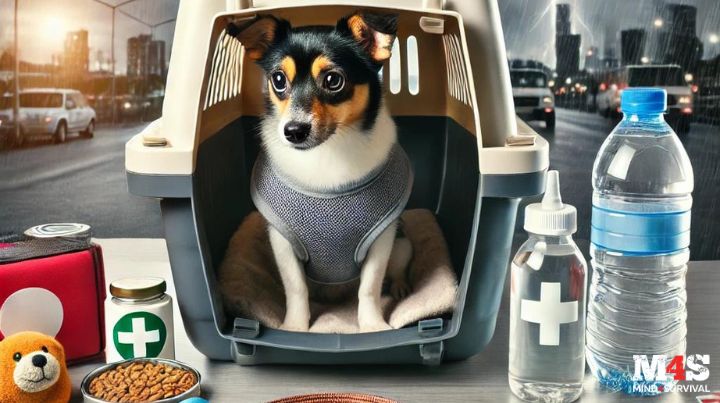Podcast: Play in new window | Download
In this latest episode of the Mind4Survival podcast, I’m excited to dive into topics that are both practical and essential for anyone on their preparedness journey. Whether you’re a longtime listener or just tuning in for the first time, I’m glad you’re here as we focus on taking steps to get better prepared, one prep at a time.
Today, we’re talking about two key areas: preparing your pets for emergencies and the importance of staying in tune with your community through something as simple as a walk around your neighborhood. These are not just theoretical ideas but practical, actionable tips you can start using today.
Quick Look at What You’ll Learn
Pet Preparedness: Ensuring Your Pets Are Ready for Anything
When the COVID-19 pandemic hit, I had to make a quick decision to leave Las Vegas. One of my first actions was to ensure my pets were ready to travel. Why? Because our pets are part of our families, and in a crisis, they depend on us more than ever.
Why Pet Preparedness Matters
Including pets in your preparedness plans is crucial. During Hurricane Katrina, about 250,000 pets were left behind, and many people chose to stay in dangerous conditions because they couldn’t take their pets with them. This shows just how important it is to have a solid plan for your furry friends. Without one, you’re not only putting them at risk but also adding to the emotional turmoil of any crisis.
Essential Pet Supplies for Emergencies
So, how can we ensure our pets are just as prepared as we are? Start with the basics:
- Food & Water: Have a two-week supply for each pet. Regularly rotate your stock to ensure nothing expires, and make sure everything is easily accessible if you need to leave quickly.
- First Aid Kit: Like your family, your pets need a kit. Include bandages, antiseptic wipes, medications, and anything specific to their health needs.
- Identification: Ensure your pets have up-to-date tags on their collars and their microchip information is current. Keep recent photos handy, both digitally and in print, in case they get lost.
- Comfort Items: Pack familiar toys, blankets, or beds to help reduce your pet’s stress during an emergency. Maintaining their routine as much as possible will help them cope better.
- Leash or Control System: Managing your pet can be challenging if you are on foot during an evacuation. A sturdy leash, harness, or hands-free leash that attaches to your waist can be invaluable in keeping your pet close and secure.
Evacuation Planning with Pets
In an emergency, having a sturdy carrier or crate for your pet is ideal, keeping them safe whether traveling by car or on foot. If you must leave on foot, a reliable leash will give you control and peace of mind. It’s especially crucial in a chaotic environment.
Finding shelter for you and your pets can be challenging, so planning ahead is wise. Look for pet-friendly shelters or consider staying with friends, family, or in hotels that welcome pets. Practice evacuation drills with your pets to familiarize them with the process, which can make all the difference when every second counts.
Special Considerations
If you have exotic pets like reptiles, birds, or small mammals, remember to account for their specific needs, such as special carriers or temperature controls. For senior pets or those with health issues, plan for their care during an emergency, including extra medications or mobility aids.
Closing Thought
Preparing for your pets is more than just a necessity—it’s a responsibility that comes with loving them as part of your family. In times of crisis, they rely on you to keep them safe, so make sure they’re as ready as you are.
Walking Through Your Neighborhood for Situational Awareness
Life throws all kinds of things our way, and one of the simplest yet most effective ways to stay connected to what’s happening in your community is to take regular walks through your neighborhood. It’s a habit I’ve made part of my daily routine, and it offers both health benefits and invaluable awareness.
Understanding Your Community’s Pulse
During your walks, take note of the people you see and how they’re interacting. Are folks friendly and relaxed, or are they tense and withdrawn? These small observations can give you a sense of the overall mood in your area.
I remember feeling the tension in the days leading up to the 1992 Los Angeles Riots, and even today, I can sense the atmosphere in my neighborhood just by paying attention to the signs around me.
Look for changes in activity levels, unfamiliar faces, or anything out of place. It’s not about being paranoid, but about being aware of what’s normal so you can recognize when something’s off.
Cooper’s Color Code for Situational Awareness
To help with this, I rely on Colonel Jeff Cooper’s Color Code, which breaks down different levels of awareness. The first level is Condition White, where you relax without thinking about the outside world. Most of the time, you want to be in Condition Yellow—relaxed but aware of what’s happening around you. If something catches your eye, you move into Condition Orange, where you’re focused on a specific potential threat, ready to take action if needed. Red is when you’re into it with the threat, and black is when the situation mentally overwhelms you.

Knowing Your Neighborhood’s Baseline
These walks also help you establish your neighborhood’s “situational baseline“—what’s typical for your area. Knowing this baseline makes it easier to spot when something is out of the ordinary, whether it’s unusual traffic, a different pattern of people, or a change in the environment.
Building Relationships and Trust
Walking your neighborhood isn’t just about observing; it’s also about building relationships. Getting to know your neighbors helps you spot what’s out of place and creates a network of people who can help you better understand your area’s normal state. This network is invaluable for sharing observations and keeping everyone alert and safe.
Wrap-Up
Next time you’re out for a walk, take the opportunity to really observe your surroundings. Notice the mood, activity levels, and changes in your neighborhood. These small details add up, giving you a clear picture of your community’s baseline. And when something changes, you’ll be the first to know, giving you the chance to act before a situation escalates.
The Bottom Line
That wraps up today’s episode of the Mind4Survival podcast. I hope you found our discussions on pet preparedness and neighborhood situational awareness both insightful and actionable. Remember, preparedness isn’t just about stockpiling supplies; it’s about being ready in every aspect of life—including caring for our pets and staying in tune with our surroundings.
What are your thoughts on this episode? Tell us in the comments below.
Additional Resources
Stay safe,

Read the full article here





